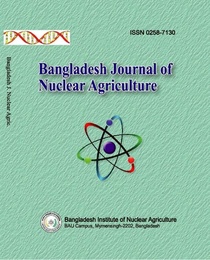ADOPTION OF BINA DEVELOPED RICE, PULSE, OILSEED AND HORTICULTURAL CROP VARIETIES IN BANGLADESH
Abstract
The study was conducted in 64 districts of Bangladesh to assess the area coverage of BINA developed rice, pulse, oilseed and horticultural crop varieties during 2021-22. Field survey data were collected from 64 districts through concern DD, DAE office. Both tabular and descriptive statistical analysis was used. It was observed that the overall area coverage of BINA developed rice varieties were 8.20%. Among the three seasons; Aus, Aman and Boro the highest area coverage was found in Aman season that was 13.04% followed by Aus 4.37% and Boro 2.76%, respectively. Among the 14 agricultural regions the highest area coverage of rice was found 17.10% in Rajshahi region (Reg-7) and the lowest found 0.70% in Dhaka region (Reg-11). The overall area coverage of BINA developed pulse varieties were 3.05% and among the 14 regions the highest area coverage for pulses was found Barishal region 69.64% (Reg-6). The overall area coverage of BINA developed oilseed varieties were 3.51% and among the 14 regions the highest area coverage for oilseed was found in Jashore region 16.12% (Reg-13) and the lowest was found in Rangamati region 1.05% (Reg-4). Among the BINA developed horticultural varieties the highest area coverage was found 0.4348% for Binalebu-1 followed by Binarosun-1 (0.3807%) and Binatomato-7 (0.1695%). It was also observed that, among the 14 regions the highest area coverage for Binalebu-1 and Binatomato-7 were found in Mymensingh agricultural region (region-2) about 210.00 ha (61.27%) and 48.00 ha (80.00%), respectively. But the highest area coverage for Binarosun-1 was found 198.00 ha (59.46%) in Rajshahi agricultural region (region-7). The study identified some constraints such as-non availability of seed, lack of training, demonstrations, field day, collaboration etc. For more dissemination, it is necessary to ensure the seed demand, training, demonstration as well as collaboration among research institutes, DAE, BADC and NGOs should be emphasized.
References
BBS (Bangladesh Bureau of Statistics). 2021. Year Book of Statistics of Bangladesh. Ministry of Planning, Govt. of the Peoples’ Republic of Bangladesh. Dhaka.
BBS (Bangladesh Bureau of Statistics). 2019. Year Book of Statistics of Bangladesh. Ministry of Planning, Govt. of the Peoples’ Republic of Bangladesh. Dhaka.
Biro, K., Pradhan, B., Buchroithner, M. and Makeschin, F. 2013. Land use/land cover change analysis and its impact on soil properties in the Northern part of Gadarif region, Sudan. Land Degrad. Dev. 24: 90-102.
Hasan, S.S., Hossain, M., Sultana, S. and Ghosh M.K. 2015. Women’s involvement in income generating activities and their opinion about its contribution: A study of Gazipur District, Bangladesh. Sci. Innov. 3: 72–80.
Hasan, Shaikh Shamim, Deng, Xiangzheng and Zhihui Li. 2017. Chen, Dongdong Projections of future land use in Bangladesh under the background of baseline, ecological protection and economic development. Sustainability. 9: 505
Leh, M., Bajwa, S. and Chaubey, I. 2013. Impact of land use change on erosion risk: An integrated remote sensing, geographic information system modeling methodology. Land Degrad. Dev. 24: 409–421.
Masangano, C.M., and Miles, C.A. 2004. Factors Influencing Farmers’ Adoption of Kalima Bean (Phaseolus vulgaris L.) Variety in Malawi. J. of Sustain. Agric, 24(2): 117-129.
Rahman, K.M.M and Islam, M.A. 2014. Nutrition-sensitive agriculture in Bangladesh: a review. Food Security. 6: 671–683.
Rogers, E. M. 2003. Diffusion of Innovations (5th ed.) New York: Free Press. p. 512
Röling, N. 1988. Extension Science, Information Systems in Agricultural Development. Cambridge University Press. Pp 233.
-
Download



